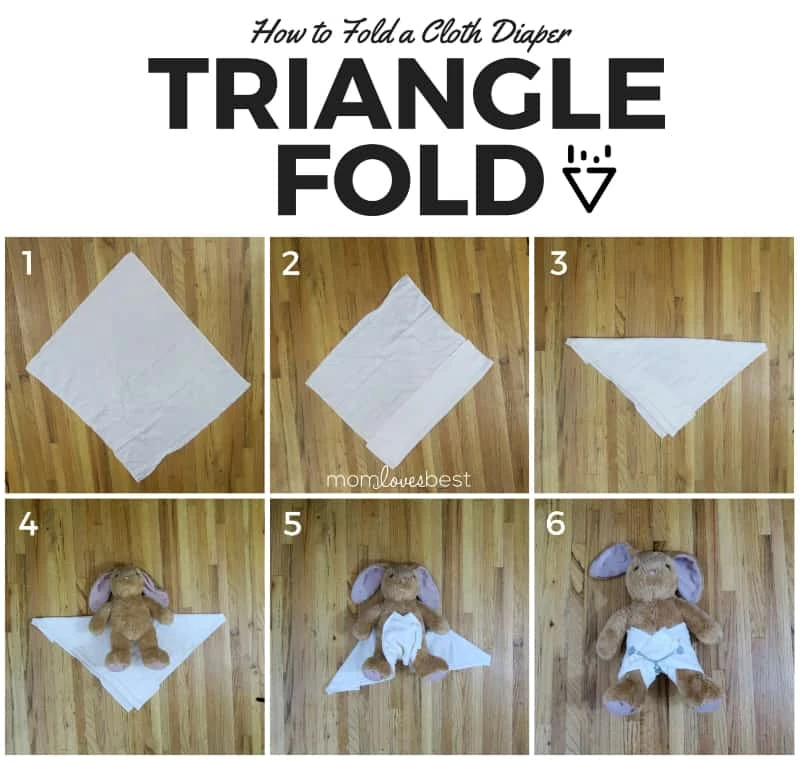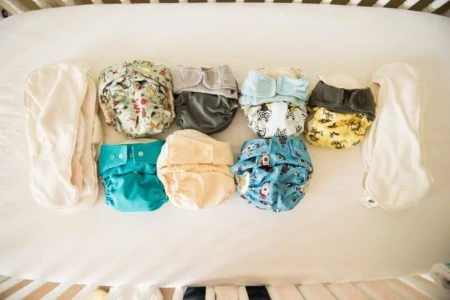You decided to use flats or prefold cloth diapers, but now you feel overwhelmed by the folding process.
Folding diapers looks intimidating at first, yet it does not have to be difficult. Many parents actually find trying new diaper folds fun once they get the hang of it.
We created this guide to teach you ten different ways to fold cloth diapers with step-by-step instructions. With a little patience and practice, you will become a diaper-folding expert in no time.
Key Takeaways
- Know the difference: Flats are large, single-layer sheets you fold for custom fit, while prefolds have a thicker, absorbent center panel and require less folding.
- Master the basics: The Angel Wing and Pad Fold are essential techniques for prefolds that work for most babies.
- Customize for absorbency: Use the Airplane or Newspaper folds to target absorbency exactly where your baby needs it most.
- Get the right gear: You must use waterproof covers and fasteners (like Snappis) to make these systems leak-proof and secure.
Comparing Flats and Prefolds
You might have chosen flats or prefolds to save money, or perhaps you love the idea of a traditional diapering method. However, you need to understand the distinct differences between these two systems before you start folding.
Understanding Flat Diapers
When you tell your grandmother you plan to use cloth diapers, she likely pictures flats. These are the most traditional option, but modern versions are much easier to use than the safety-pin-and-rubber-pant combos of the past.
Quick Definition
You can use dish towels, flour sack towels, receiving blankets, and even old t-shirts to make flat diapers.
Flats offer incredible versatility:
- One size fits most: You use the same flat diapers from birth until potty training by adjusting the fold.
- Customizable absorbency: You easily double them or add inserts to create more layers.
- Trim fit: They generally are not super bulky under your baby’s clothing.
- Easy maintenance: Flats are easy to wash and dry faster than any other style, which simplifies laundry day.
Understanding Prefold Diapers
Prefold diapers function similarly to flats, but they come with a helpful head start. Manufacturers sew these diapers with multiple layers of fabric in the center panel, meaning they are “pre-folded” for absorbency.
Prefolds are smaller and thicker than flats. Instead of folding the entire diaper to create absorbency, you simply fold it to fit your baby.
Here is why parents love prefolds:
- Affordability: They are the second most affordable option after flats.
- Durability: These diapers withstand heavy washing and last through multiple children.
- Absorbency: The layered center handles heavy wetters well.
Unlike flats, one prefold size will not last from birth to potty training. You typically need to buy larger sizes as your baby grows.
Gathering Essential Accessories
Flats and prefolds require two specific accessories to function as a complete diaper change.
Fasteners
Skip the sharp safety pins. Modern parents keep diapers secure with a Snappi fastener. This T-shaped rubber tool features plastic teeth on each end that grip the fabric weave to hold the diaper in place.
Waterproof Covers
Flats and prefolds are absorbent, but they are not waterproof. You must place a water-resistant cover over them to prevent leaks.
Most parents use covers made of polyurethane laminated fabric (PUL). These covers look like the outside of an All-in-One diaper and close with snaps or Velcro. Many come in “one-size” options that adjust to fit your baby from the newborn stage through toddlerhood.
Mastering Prefold Diaper Folds
I will let you in on a secret: many folding methods for prefolds also work for flats. However, flats usually require a few extra steps to get down to size.
We broke down five easy ways to fold a prefold diaper. Remember, you can always increase absorbency by laying a second, smaller insert inside any of these folds.
1. Angel Wing Fold
The Angel Wing fold remains the industry standard for a reason. It offers great coverage and creates a “poop pocket” to contain messes.
How to do it:
- Lay it flat: Place the diaper on your changing surface.
- Fold the front: Fold the front panel into thirds (tri-fold) while leaving the back panel flared out flat. The back corners are your “wings.”
- Position the baby: Place your baby on the diaper so the wings are at their waist.
- Secure it: Pull the front panel up between the legs. Wrap the back wings around to the front and secure everything with a Snappi. Cover with a waterproof shell.
2. Jelly Roll Fold
The Jelly Roll is the ultimate defense against newborn blowout leaks. The rolled edges create a seal around the legs that keeps liquid stool off the diaper cover.
How to do it:
- Start flat: Lay the diaper out comfortably.
- Roll the sides: Roll the long edges inward toward the center, creating barriers. Leave the back part flat.
- Apply to baby: Fold the front up between the baby’s legs, cupping the rolls against the thigh creases.
- Fasten: Wrap the back wings around the waist and secure with a Snappi.
3. Pad Fold
The Pad Fold (or Tri-Fold) converts your prefold into a simple rectangular insert. This is the easiest method and works perfectly inside covers or stuffed into pocket diapers.
How to do it:
- Position the diaper: Start with the diaper flat on your changing pad.
- Fold once: Fold one outside section over the center seam.
- Fold twice: Fold the other outside section over the first one. You now have a thick rectangle.
- Insert: Lay this directly into a diaper cover or stuff it inside a pocket diaper. No Snappi required.
4. Newspaper Fold
The Newspaper fold functions as a modified Angel Wing. It provides extra layers in the front, making it ideal for boys or tummy sleepers.
How to do it:
- Fold up: Lay the diaper flat and fold the front edge up about a quarter of the way.
- Tri-fold the front: Fold the sides of that front section into the center. Leave the back section flat to create wings.
- Secure: Place the baby on the diaper, pull the front up, wrap the wings around, and fasten.
5. Bikini Fold
The Bikini fold provides a high-cut fit that allows for maximum leg movement. It places absorbency in the middle, which works well for girls. Avoid this for loose newborn stools as it lacks containment at the legs.
How to do it:
- Twist it: Lay the diaper flat, then twist the center fabric 180 degrees.
- Tuck and pull: Pull the front fan up over the baby.
- Wrap: Tuck the front corners under the baby’s hip, then wrap the back wings around to the front and fasten with a Snappi.
Mastering Flat Diaper Folds
Flat diapers offer more versatility because you have more fabric to manipulate. You can fold them to suit any baby shape or size.
1. Diaper Bag Fold
The Diaper Bag fold earns its name because it is neat, compact, and stackable. You can prep a dozen of these and stack them ready for the day.
How to do it:
- Initial fold: Place the diaper flat. Fold the sides into the center. Fold the bottom edge up to size it for your baby.
- Angle fold: Fold the front corners inward at an angle so they overlap slightly in the middle.
- Create the pocket: Fold the back edge down a few inches to create a “poop fence” barrier.
- Apply: Lay the baby down, pull the front up, and wrap the back wings around the waist. Secure with a Snappi.
Travel Tip
2. Airplane Fold
The Airplane fold concentrates layers in the front zone, making it a top choice for boys.
How to do it:
- Square it up: Lay the diaper flat. If rectangular, fold one side down to create a perfect square.
- Center meet: Fold the bottom left and bottom right corners into the center so they touch. Fold the resulting bottom point up to the center as well.
- Fold the top: Bring the top left and right corners into the center. You can overlap these for extra bulk if desired.
- Final tuck: Tuck the top corners into the folds. Place the baby on top, fold up, and secure.
3. Triangle Fold
We love the Triangle fold for beginners. It is fast, intuitive, and impossible to mess up. It is great for a quick change but offers less absorbency than complex folds.
How to do it:
- Make a triangle: Lay the diaper flat. Fold it in half diagonally to form a large triangle with the point facing you.
- Position baby: Place the baby so the long edge is at their back and the point is between their legs.
- Fold and secure: Pull the point up over the belly. Wrap the side wings around the waist and fasten.
4. Kite Fold
The Kite fold takes a bit of practice, but it rewards you with a trim fit and six layers of absorbency through the wetting zone.
How to do it:
- Create the kite: Position the diaper diagonally (diamond shape). Fold the side corners into the center.
- Fold down: Bring the top corner down to the center.
- Fold up: Fold the bottom corner up about a quarter of the way, then fold it again to meet the center.
- Apply: Place the baby on the diaper, pull the bottom flap up, wrap the wings, and Snappi.
5. Origami Fold
Do not let the name scare you. The Origami fold is a parent favorite because it creates a neat, square shape with a built-in absorbent pad in the middle.
How to do it:
- Quarter fold: Fold the diaper in half, then in half again to make a small square.
- The pull: Pull the top layer of the top-left corner out to the right, creating a triangle shape. Flip the whole diaper over.
- The pad: Fold the square section on the left over toward the center three times to create a thick pad.
- Apply: Lay the baby down, pull the pad up between legs, wrap the wings, and secure.

















